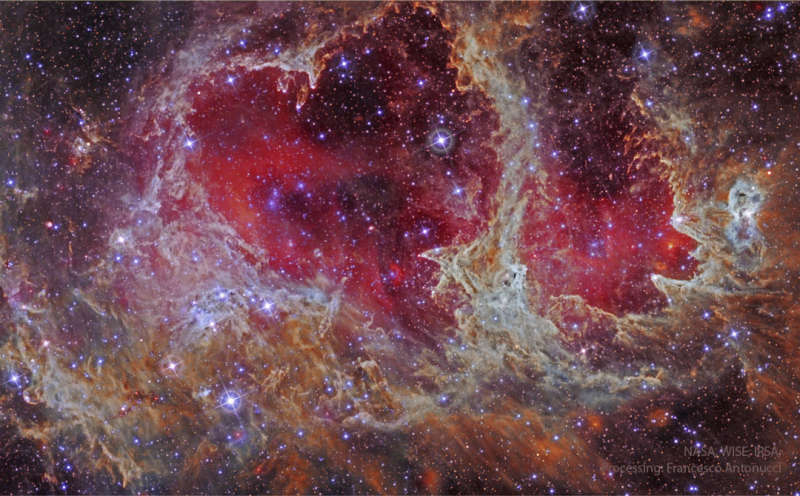Авторы и права: НАСА,
спутник WISE,
Инфракрасный научный архив;
Обработка и авторские права:
Франческо Антонуччи
Перевод: Д.Ю.Цветков
Пояснение:
Как формируются звезды?
Исследование области звездообразования
W5
в
инфракрасном
свете спутником НАСА WISE (Wide Field Infrared Survey Explorer – Исследователь
широкоугольного
инфракрасного обзора)
дает новые данные для ответа на этот вопрос. Обнаружено,
что массивные звезды около центров пустых полостей старше, чем звезды около их краев.
Наиболее вероятная причина – более старые звезды в центре
инициируют
формирование молодых звезд на краю полости.
Индуцированное
звездообразование
происходит, когда горячий, текущий наружу газ сжимает более холодный газ в
плотные сгустки,
которые затем продолжают сжиматься и превращаются в звезды под действием гравитации.
Эффектные столбы,
медленно испаряющиеся при взаимодействии с потоком горячего газа,
являются еще одним наблюдаемым свидетельством этого процесса.
На
этом
инфракрасном
изображении цвета подобраны для удобства исследования:
в красный цвет окрашена нагретая
пыль,
а в белый и зеленый – особенно плотные облака газа.
W5
известна также как
IC 1848,
вместе c IC 1805 они образуют
сложную область звездообразования, популярное название которой – туманности
Сердце
и Душа.
На
этом
изображении
показана часть W5 размером около двух тысяч
световых лет,
особенно богатая
столбами, в которых образуются звезды.
W5
находится на расстоянии 6500 световых лет в
созвездии
Кассиопеи.
Астрономической картинке дня исполнилось 30 лет!:
Бесплатная публичная лекция в Корке, Ирландия, завтра в 7 часов вечера
1999 2000 2001 2002 2003 2004 2005 2006 2007 2008 2009 2010 2011 2012 2013 2014 2015 2016 2017 2018 2019 2020 2021 2022 2023 2024 2025 |
Январь Февраль Март Апрель Май Июнь Июль Август Сентябрь Октябрь Ноябрь Декабрь |
NASA Web Site Statements, Warnings, and Disclaimers
NASA Official: Jay Norris. Specific rights apply.
A service of: LHEA at NASA / GSFC
& Michigan Tech. U.
|
Публикации с ключевыми словами:
star formation - звездообразование
Публикации со словами: star formation - звездообразование | |
См. также:
Все публикации на ту же тему >> | |
